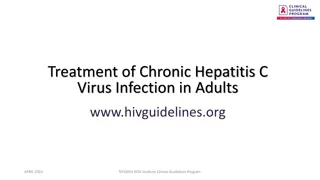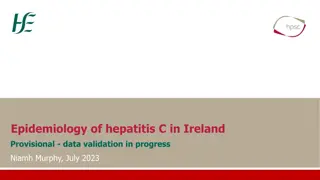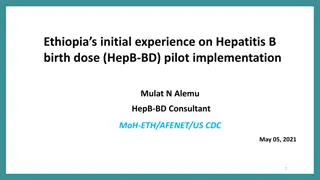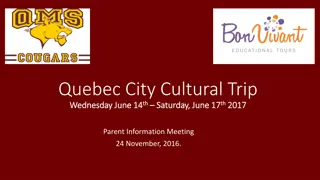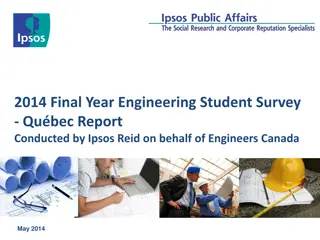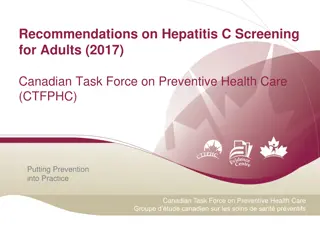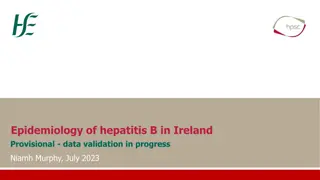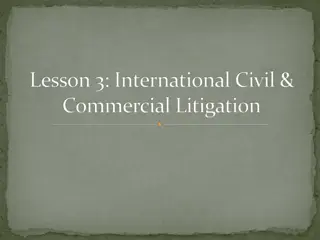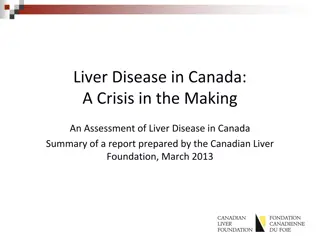Healthcare Utilization in Quebec Immigrants and Non-Immigrants with Chronic Hepatitis C Infection
This study, supervised by Dr. Christina Greenaway, aims to estimate and compare healthcare utilization in Quebec immigrants and non-immigrants diagnosed with chronic Hepatitis C infection. The research seeks to identify predictors of all-cause and liver-related healthcare utilization. With rising healthcare costs projected due to HCV, understanding differences in healthcare use between these groups can inform policy-making and treatment efforts. Immigrants, often from high-prevalence regions, form a unique subgroup within the HCV-infected population. The study addresses the need for data on healthcare utilization in this context.
Download Presentation

Please find below an Image/Link to download the presentation.
The content on the website is provided AS IS for your information and personal use only. It may not be sold, licensed, or shared on other websites without obtaining consent from the author.If you encounter any issues during the download, it is possible that the publisher has removed the file from their server.
You are allowed to download the files provided on this website for personal or commercial use, subject to the condition that they are used lawfully. All files are the property of their respective owners.
The content on the website is provided AS IS for your information and personal use only. It may not be sold, licensed, or shared on other websites without obtaining consent from the author.
E N D
Presentation Transcript
HEALTHCAREUTILIZATIONIN QUEBEC IMMIGRANTSANDNON-IMMIGRANTS WITHCHRONICHEPATITIS C INFECTION Supervisor: Dr. Christina Greenaway Thesis committee: Dr. Laurent Azoulay Dr. Marina Klein Dr. Russell Steele Rhiannon Kamstra M.Sc. Student McGill EBOH 50th Anniversary May 1st, 2015
Chronic Hepatitis C Up to 85% of people infected by Hepatitis C Virus become chronically infected Cirrhosis 30% develop liver disease in 20-30 years HCC Liver failure Transplant 2 WHO Guidelines (April 2014)
Transmission 300k cases/year from unsafe injections MEDICAL PROCEDURES BLOODPRODUCTS Pre-screening era 60% of new cases in Canada INJECTIONDRUGUSE 3
Burden 350k 185 million infections worldwide 250,000 global deaths per year Canadians infected At least 35% of cases are undetected Mohd Hanafiah et al. Hepatology (2013) Lavanchy D. Liver Int. (2009) Hepatitis C In Canada: 2005-2010 Surveillance Report (PHAC) 4
Rising healthcare use Projected 60% increase in annual costs due to HCV in Canada over the next 20 years(Myers 2014) 5 Myers et al. Can J Gastroenterol Hepatol (2014) Hepatitis C In Canada: 10 2005-2010 Surveillance Report (PHAC)
Immigrants Often migrate from regions with high prevalence Different risk factors and health status Very limited data modelling estimates suggest 20% of cases in Canada occur in immigrants 6 Hepatitis C In Canada: 2005-2010 Surveillance Report (PHAC) Evolving epidemiology of hepatitis C virus. Lavanchy (2011)
Rationale WHY? Inform policy and planning with data about healthcare utilization in the Quebec HCV-infected population Immigrants are a unique subgroup understanding differences will help prevention and treatment efforts 7
Objective Estimate and compare all-cause and liver-related healthcare utilization for immigrants and non-immigrants with HCV, identifying predictors of utilization 8
Study Design Retrospective longitudinal cohort study Cases ascertained from mandatory reportable disease database (MADO) from 1998-2007 Loss of RAMQ coverage (>6 months) Death 1 year prior to diagnosis End of study Dec. 31, 2007 Date of diagnosis Censoring Assess prevalent comorbidities Measure incident healthcare utilization 9
Deterministic linkage RAMQ ID AGE SEX LOCATION COVERAGE PHYSICIAN BILLING OUTPATIENTVISITS BILLINGCODES Deterministic linkage VISA # MED-ECHO HOSPITALIZATIONS DIAGNOSTICCODES PROCEDURES ARRIVALDATE COUNTRYOFORIGIN HEALTHSERVICES DATA 10
Cohort Selection 11
Definitions Focused on hospitalizations as measure of healthcare utilization Liver-related complications are serious Primary measures of healthcare utilization Hospital stays (N) Days in hospital (N) Liver-relatedhospitalizations required at least one diagnostic code (ICD 9, ICD 10, or procedure code) to match a specified list (including cirrhosis, liver transplant, liver cancer) Prevalent comorbidities were identified using hospitalizations and physician billing using ICD 9 and 10 codes 12
Analysis Summarize and compare characteristics of hospitalizations in immigrants and non- immigrants (e.g., mean N per subject, rate per 100PY, length of stay, reason for stay) 1 Examined influence of demographic differences on rate of hospitalizations in immigrants/non-immigrants using negative binomial modelling 2 13
Demographics N = 20,139 cases (1998-2007) Median follow-up: 3.9 years (immigrants) 4.8 years (non-immigrants) Immigrants accounted for 9% of cases 26% originated from East Asia/Pacific (most common region of origin) Time from arrival to diagnosis was 9.8 6.9 years 14
Demographics Immigrants Olderat diagnosis (47.6 years vs. 43.2 years) Only 53% male (vs. 68%) 78% located in Montreal (vs. 38%) Drug/alcohol related 4-10x more common in non-immigrants 30 Immigrants Non-immigrants 25 20 Prevalence (%) More frequent in immigrants at baseline 15 10 5 0 15
All-cause hospitalizations Most subjects were never hospitalized during follow-up. Non-immigrants had a higher burden of all-cause hospitalizations 49.3% of non-immigrants ever hospitalized Stays per subject and per person-time higher in non-immigrants Immigrants N = 1821 Non-immigrants N = 18318 Characteristic p N (%) ever hospitalized Total hospitalizations (N) Mean stays per person (95% CI) Crude rate of stays / 100 PY Mean days per person (95% CI) Crude rate of hospital days / 100 PY 167.3 652 (35.80) 1525 0.84 (0.76-0.92) 22.1 (20.2-24.2) 7.34 (6.31-8.37) 9032 (49.31) 29239 1.60 (1.56-1.64) 37.1 (36.2-38.1) 15.77 (15.01-16.53) 325.7 <.0001 <.0001 <.0001 11.37 16.61 11.51 25.25 Mean length of stay SD (days) 16
All-cause hospitalizations Category of primary diagnosis % of all hospitalizations Immigrants Non-immigrants 1 1 Liver/viral hepatitis 11.6% Mental disorders 20.5% Nervous system/ sense organs 10.2% Injury & poisoning 10.3% 2 2 3 3 Pregnancy/childbirth 8.7% Digestive system (excl. liver) 8.7% 17
Liver-related hospitalizations 7.2% of subjects contributed all liver-related stays Immigrants N = 1821 Non-immigrants N = 18318 Characteristic p N (%) ever hospitalized 142 (7.80) 1299 (7.09) 0.27 Total hospitalizations (N) 286 3164 Mean stays per person (95% CI) 0.16 (0.13-0.19) 0.17 (0.16-0.18) 0.63 Crude rate of stays / 100 PY 6.4 (4.7-8.6) 5.8 (5.3-6.4) Mean days per person (95% CI) 2.32 (1.72-2.92) 2.37 (2.16-2.58) 0.89 Rate of hospital days / 100 PY 52.9 48.8 15.17 21.02 14.04 21.11 Mean length of stay SD (days) Liver-related hospitalization was similar for immigrants and non-immigrants despite comorbidities Most in-hospital deaths inimmigrants were liver-related (57.9% vs. 41.8%) 18
Modelling What is driving similar rates of liver-related hospitalization vs. different all-cause All-cause hospitalizations Univariate Rate ratio, 95%CI Multivariate (Rate ratio, 95%CI Covariate p p Immigrant status Non-immigrant Immigrant Age (cont.) Sex M F REFERENCE 0.60 (0.54-0.65) 1.02 (1.02-1.02) REFERENCE 0.52 (0.47-0.57) 1.02 (1.02-1.02) <.0001 <.0001 <.0001 <.0001 REFERENCE 1.26 (1.16-1.29) REFERENCE 1.28 (1.21-1.34) <.0001 <.0001 19
Modelling What is driving similar rates of liver-related hospitalization vs. different all-cause Liver-related hospitalizations Univariate Rate ratio, 95%CI Multivariate (Rate ratio, 95%CI Covariate p p Immigrant status Non-immigrant Immigrant Age (cont.) Sex M F REFERENCE 1.10 (0.80-1.49) 1.09 (1.08-1.09) REFERENCE 0.69 (0.52-0.92) 1.09 (1.08-1.09) <.5652 <.0001 0.0102 <.0001 REFERENCE 0.89 (0.74-1.06) REFERENCE 0.69 (0.59-0.82) 0.1935 <.0001 Relative rate of liver-related affected by different age and sex distribution 20
Discussion Immigrants are different implications for prevention and treatment Non-immigrants have more all-cause hospitalization but similar liver-related Despite more prevalent risk factors for progression (alcohol, HIV) Suggests other drivers of liver-related in immigrants Older age (late detection) 21
Main limitations Passive detection and reporting Symptom-based screening Determined by care-seeking Non-linkage 20% non-linkage to RAMQ Limited accuracy of diagnostic coding Defining liver-related stays, comorbidities Detection depends on care seeking Reference group 22
Acknowledgements Supervisor: Dr. Chris Greenaway Thesis committee members: Dr. Laurent Azoulay Dr. Marina Klein Dr. Russ Steele Members of the Greenaway team: Alain, Viet, Nour & Catherine McGill and LDI staff 23
References & Resources Lavanchy, D. "The global burden of hepatitis C." Liver International 29.s1 (2009): 74-81. Lavanchy, D. "Evolving epidemiology of hepatitis C virus." Clinical Microbiology and Infection 17.2 (2011): 107-115. Lozano R, Naghavi M, Foreman K, Lim S, Shibuya K, Aboyans V, et al. Global and regional mortality from 235 causes of death for 20 age groups in 1990 and 2010: a systematic analysis for the Global Burden of Disease Study 2010. The Lancet. 2012; 380(9859): 2095-128. Mohd Hanafiah K, Groeger J, Flaxman AD, Wiersma ST. Global epidemiology of hepatitis C virus infection: New estimates of age-specific antibody to HCV seroprevalence. Hepatology. 2013; 57(4): 1333-42. Myers, Robert P., et al. "Burden of disease and cost of chronic hepatitis C virus infection in Canada." Canadian journal of gastroenterology & hepatology28.5 (2014): 243. Public Health Agency of Canada. Hepatitis C in Canada: 2005-2010 Surveillance Report; 2012. (Online) Remis RS. Modelling the incidence and prevalence of hepatitis C infection and its sequelae in Canada, 2007. Health Canada, Ottawa: Final report. 2007. World Health Organization (WHO). Guidelines for the screening, care and treatment of persons with hepatitis C infection. April 2014. (Online) 24
Questions 25


